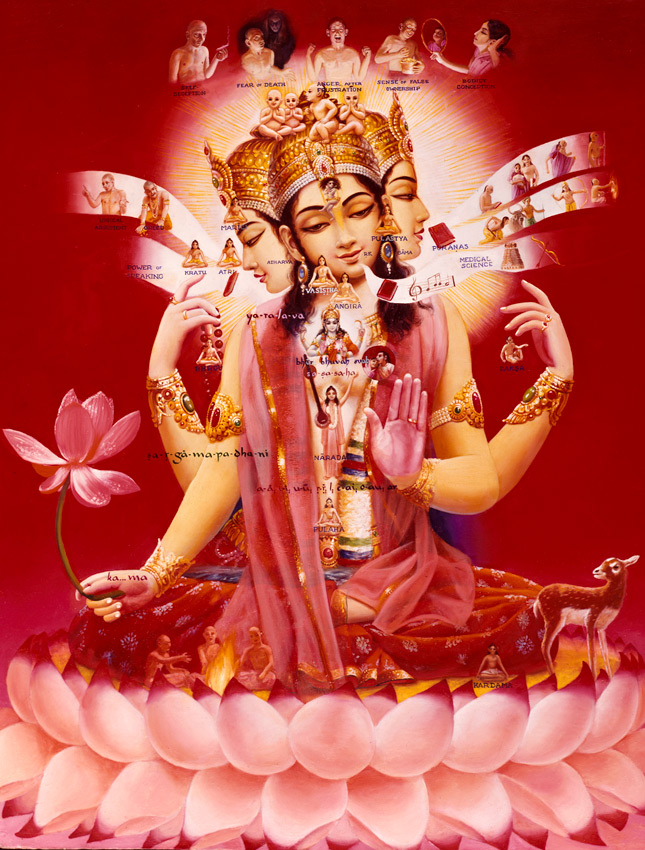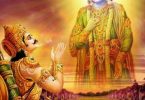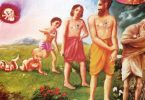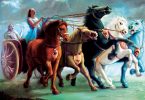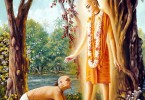Question: What is the rasa of our Lord Brahma?
Answer by Romapada Swami: The findings below indicate at least two messages:
1. Acaryas sometimes have different opinions; even the same acarya sometimes expresses variant points of view elsewhere in his writings, or partial aspects of their own view.
2. Three different rasas are identified as Brahma’s rasa, and not one of them stands out as a definitive statement as “this is the rasa of our current Lord Brahma.”
Brahma Research
1. Brahma as a Maidservant of Kåñëa
Context: Brahma’s realization after gayatri chanting, found in Brahma Samhita
Summary: Brahma realized his identity as a maidservant, although the refined and further mysteries regarding his relationship as a maidservant of Kåñëa were not yet revealed to him.
Çréla Bhaktisiddhänta Sarasvaté purport to text of Çré Brahma-saàhitä 5.28
Brahmä thought thus within himself, “By the recollection of käma-gäyatré it seems to me that I am the eternal maidservant of Kåñëa.” Though the other mysteries in regard to the condition of the maidservant of Kåñëa were not revealed to him, Brahmä, by dint of his searching self-consciousness, became well acquainted with the ocean of truth. All the truths of the Vedas were revealed to him and with the help of those essences of the Vedas, he offered this hymn to the Supreme Lord Çré Kåñëa. Çrémän Mahäprabhu has taught this hymn to His favorite disciples in as much as it fully contains all the transcendental truths regarding the Vaiñëava philosophy. Readers are requested to study and try to enter into the spirit of his hymn with great care and attention, as a regular daily function.
Biography: “The Life and legacy of Sripada Madhavacarya Bhagavatapada”
Being freed from all materialistic desires to enjoy in the material world, Lord Brahma, the devotee, is a willing recipient of the Lord’s mercy.
Brahma thought to himself, “By the recollection of the Kama Gayatri mantra it seems to me that I am the eternal maidservant of Krsna.” Thus all the truths of the Vedas were consequently revealed to him by the Lord from within.
2. Sakhya Rasa evidence
Context: Lord Visnu presents himself before Brahma, after Brahma’s performance of extended tapasya.
Summary: SB 2.9.30: Lord touches/shakes hands with Brahma. Some acaryas indicate the Lord’s touch to simply be an expression of his loving affection for Brahma or a gesture of encouragement for Brahma, while other acaryas read this gesture as explicit confirmation of a formal friendship relationship.
VCT: 2.9.19
The Lord, overjoyed, filled with prema for Brahmä, touching Brahmä with his hand because of his love for him, with words lit by a slight smile, spoke to Brahmä, who was filled with prema on seeing the Lord, and who was worthy of following the Lord’s command for creating the universe.
COMMENTARY
Brahmä was fit to follow the orders of the Lord (nija-çäsanärhaëam). The Lord’s words were lit with a slight smile.
VCT: Sarartha Darshini-tika: SB 2.9.29 and 30
SB 2.9.29
Without lethargy may I carry out instructions on how to worship you as given by you, because by your mercy alone I will not be bound by false ego when I carry out the creation.
COMMENTARY
May I carry out instructions given by the Lord. Since you are my guru, please give me, your disciple, some instructions on how to worship you, because by your mercy, though I carry out the creation of the offspring, I should not be bound by false ego.
SB 2.9.30
I have been treated by you as a friend treats a friend. O Lord! As long as my tenure lasts, without lethargy, being situated in your service, I will create various types of living entities in the matter of carrying out creation. May I not be overcome by excessive pride in this endeavor.
COMMENTARY
Brahmä, revealing his desire, prays to the Lord. O Lord! You have treated me as a friend treats a friend, by touching me with your hand, though I am just a shadow of a servant! May I attain bhakti with a feeling of friendship! O Lord (bho)! As long as I live, while creating the bodies of the living entities, I will create divisions of high, medium and low, while being situated with attention (aviklavaù) in serving you. May I not become overcome with excessive pride. The extent of Brahmä’s life is expressed by yävad-adhikäram avasthitir ädhikärikäëäm: those who hold powers in this world as controllers remain in this world until their tenure has expired. (Brahma-sütra 3.3.33)
Jiva Goswami: Bhagavat Sandarbha [Trans by Bhanu Swami] 8
The Lord, overjoyed, filled with prema for Brahmä, touching Brahmä with his hand because of his love for him, with words lit by a slight smile, spoke to Brahmä, who was filled with prema on seeing the Lord, and who was worthy of following the puruña’s command for creating the universe. SB 2.9.9-18
The Lord spoke to Brahmä, who had prema for the Lord and was qualified to follow the order (çäsanärhanam) of the puruña who is Kåñëa’s aàça (nija) for creating progeny.
“The puruña can give mercy to Brahmä. But since Bhagavän is superior to the puruña, he has no relation to material creation. Brahmä should relate to the agent for material creation.” But Bhagavän is very affectionate to his devotee. He spoke to Brahmä from whom he had great prema (priyam), since he is controlled by prema (priyaù). Brahmä was overjoyed with prema (préyamäëam) and the Lord was extremely pleased (prétamanäù). The Lord’s great joy is indicated by the Lord’s actions: he smiled slightly and touched Brahmä’s hand. That Brahmä was a worshipper of Kåñëa is shown in the statement from Gopäla-täpané Upaniñad.
Brahma-saàhitä says:
evaà sarvätma-sambandhaà näbhyäà padmaà harer abhüt |
tatra brahmäbhavad bhüyaç catur-vedi catur-mukhaù ||22||
A lotus appeared in the navel of the Lord for the mass of jévas. In that lotus, Hiraëyagarbha Brahmä appeared, and then the Brahmä with four mouths and the four Vedas.
sa jäto bhagavac-chaktyä tat-kälaà kila coditaù |
sisåkñäyäà matià cakre pürva-saàskära-saàskåtaù |
dadarça kevalaà dhväntaà nänyat kim api sarvataù ||23||
At that time, Brahmä, after appearing, inspired by the energy of the Lord, developed the desire to create the worlds under the influence of his previous impressions. But he saw only darkness and nothing else in all directions.
uväca puratas tasmai tasya divya sarasvaté |
kämaù kåñëäya govinda he gopé-jana ity api |
vallabhäya priyä vahner mantram te däsyati priyam ||24||
A divine voice then spoke to him directly and gave him the dear mantra composed of the käma-béja, the words kåñëäya, Govinda, gopé-jana-vallabhäya and the syllable dear to fire (svähä). Brahma-saàitä 5.22-24
Jiva Goswami: Bhagavat Sandarbha [another English translation] Anuccheda 10
7 “Lord Brahma saw in the Vaikuntha planets the Personality of Godhead, who is the Lord of the entire devotee community, the Lord of the Goddess of fortune, the Lord of all sacrifices, and the Lord of the universe, and who is served by the foremost servitors like Nanda, Sunanda, Prabala and Arhana, His immediate associates.
8 “The Personality of Godhead, seen leaning favorably towards His loving servitors, His very sight intoxicating and attractive, appeared to be very much satisfied. He had a smiling face decorated with an enchanting reddish hue. He was dressed in yellow robes and wore earrings and a helmet on His head. He had four hands, and His chest was marked with the lines of the goddess of fortune.
9 “The Lord was seated on His throne and was surrounded by different energies like the four, the sixteen, the five, and the six natural opulences, along with other insignificant energies of the temporary character. But He was the factual Supreme Lord, enjoying His own abode.
10 “Lord Brahma, thus seeing the Personality of Godhead in His fullness, was overwhelmed with joy within his heart, and thus in full transcendental love and ecstasy, his eyes filled with tears of love. He thus bowed down before the Lord. That is the way of the highest perfection for the living being (paramahamsa).
11 “And seeing Brahma present before Him, the Lord accepted him as worthy to create living beings, to be controlled as He desired, and thus being much satisfied with him, the Lord shook hands with Brahma and, smiling, addressed him thus.
12 The first of these verses (2.9.9 quoted in Text 1) should be interpreted in the following way: Brahma stayed in the lotus flower of the navel of the Purusa-avatara named Narayana, and there he worshipped the Lord by performing austerities for His satisfaction, as the Lord Himself had previously ordered. The Supreme Lord became pleased with Brahma (sabhajita) and showed him His own (sva-lokam) Vaikuntha realm, the topmost of all planetary systems. In this verse the word ‘yat-param’ may be interpreted to mean “The highest of all Vaikuntha planets: the abode of the original form of the Personality of Godhead”, or it may also be interpreted to mean ‘the Vaikuntha realm which is not different from the Supreme Truth, Brahman Himself.”
This Vaikuntha realm is described in these verses as full of transcendental varieties and free from the influence of the illusory potency, maya.
13 In this verse (2.9.9) the Vaikuntha realm was revealed to Brahma. Vaikuntha is described here as free from all miseries and fears (vyapeta-sanklesa-vimoha-saddhvasam). According to Patanjali’s Yoga-sutras (Sadhana-pada, Sutra 3), the five miseries of material existence are 1. Ignorance, 2. False-ego, 3. Lust, 4. Hatred, and 5. Attachment. Vaikuntha is free from these and all other sufferings. Self-realized souls are able to see Vaikuntha (sva-drstavadbhih), and they always worship and glorify it (abhistutam).
3. Dasya Rasa
Context: Rasa Lila chapters; Brahma-vimohana-lila; Priti Sandarbha
Summary: transformation of Brahma to transcendental ecstatic love, Sanatan Goswami commentary on SB 10.13.64 mentions relationship as dasya rasa
Jiva Goswami: Vaisnava Tosani SB 10.33.3 (last Paragraph of Purport)
Those who by their nature roam in the sky gathered together on suddenly seeing the räsa dance. The sky became filled with airplanes. Or they gave up the direction where the moon and rose above the moon into the open sky. “The inhabitants of the sky” refers to Brahmä, Çiva, and others. This means there were no such festivals in Svarga or other planets. They became eager for the dancing part of the räsa, not the confidential pastimes, since they were not qualified, being in däsya-räsa. They came for the dancing. The confidential pastimes were hidden from them by yogamäyä.
VCT: Sarartha Darshini-Tika 10.33.3 (last Paragraph of Purport)
At that moment (tävat), the sky became crowded with hundreds of airplanes belonging to the denizens of heaven, headed by Brahmä. They eagerly watched Kåñëa’s räsa dancing, but they were not qualified to witness Kåñëa’s confidential pastimes with the gopés because they are däsya-bhaktas, worshiping Him in the mood of servitude. Yogamäyä thus arranged everything so expertly that the men of heaven could see the dancing of Kåñëa but not His beloved gopés.
Jiva Goswami: Priti Sandarbha 218
Now the devotional mellow of praçraya-rasa (filial love) will be considered. In this rasa, the alambana and visaya are Lord Kåñëa, the doting parent. The ädhära (lovers) are Lord Kåñëa’s children and other like kinsmen who are the objects of His parental affections. As before, in this rasa also Lord Kåñëa manifests two forms: 1. the form of the supreme controller, and 2. a humanlike form. The devotees who are thus the objects of Lord Kåñëa’s parental affection are of three kinds: 1. the devotees who have a relationship with the Lord in His feature as the supreme controller, 2. the devotees who have a relationship with the Lord in His humanlike feature, and 3. the devotees who have a relationship with the Lord in both these two features. The demigod Brahmä and other demigods have a relationship with the Lord in His feature as the supreme controller. The children in Gokula, which is revealed in the twelve-syllable mantra, have a relationship with the Lord in His humanlike feature. The Lord’s children born to Him at Dvärakä have a relationship with the Lord in both these features. This filial relationship includes Lord Kåñëa’s own children, nephews, nieces, followers, and other like persons. Some of Lord’s Kåñëa’s children have qualities like their father, and others have forms like their father. The Lord’s children who have qualities like those of their father are described in these words of Çrémad-Bhägavatam (10.61.1):
ekaikaças täù kåñëasya puträn daça-daçäbaläù ajéjanann anavaman pituù sarvätma-sampadä
“Each of Lord Kåñëa’s wives gave birth to ten sons, who were not less than their father, having all His personal opulence.”
Bhanu Swami’s Translation of the same Priti Sandarbha 218 text
Now praçraya-bhakti-maya-rasa will be discussed. The älambana is Kåñëa, the viñaya of praçraya-bhakti, appearing as one who caresses. He takes two forms: the Supreme Lord and the human form. Those who take shelter of these forms are the lälyas (to be caressed, his children). Those who relate to the form of the Supreme Lord are Brahmä and others (who are sons). Brahmä is also classed with äçraya-bhakti-maya-rasa.
Those who relate to the human form for shelter are the young boys of Gokula portrayed in the meditation on the ten syllable mantra. Young boys would take Kåñëa as an elder brother. Those sons born in Dvärakä take shelter of both forms. All these are sons, younger brothers, sons of brothers, and similar persons. Some are very similar in qualities and some very similar in form and some very similar in qualities and form.
Similarity in qualities is described:
ekaikaças täù kåñëasya puträn daça-daçäbaläù
ajéjanann anavamän pituù sarvätma-sampadä
Each of Kåñëa’s wives gave birth to ten sons, who were not less than their father, having all his personal opulence. SB 10.61.1
VCT: Sarartha Darshini-Tika: SB 10.9.20
Neither Lord Brahmä, nor Lord Çiva, nor even the goddess of fortune, who is always the better half of the Supreme Lord, can obtain from the Supreme Personality of Godhead, the deliverer from this material world, such mercy as received by mother Yaçodä.
COMMENTARY
This verse is spoken on seeing the exceptional devotion of the queen of Vraja, who among all the devotees brought Kåñëa under Her control. vimukti here means viçeña-mukti, specialized liberation or prema. Vimuktidät means Kåñëa, the giver of prema.
viriïco: Lord Brahmä; The inconceivable mercy that Yaçodä obtained from Kåñëa, the giver of prema, was never received by Brahmä, Çiva (bhavo), or even Laksmé-devi (srér).
This verse contains three negative pronouncements; nemaà, na bhavo and na çrér. Three repetitions emphasize the exceeding absence of mercy offered to these personalities. However, with the word “indeed” (apy) the sentence can mean that even though they received mercy, it was not to the extent of Yaçodä.
Lord Brahmä is the son of Bhagavän Çré Kåñëa and the ädi-guru of the devotees, sa ädi-devo jagatäà paro guru (Bhag. 2.9.5). As the topmost Vaiñëava (vaiñëavänäà yathä çambhuù), Çiva is considered superior to Brahmä. The goddess of fortune, Laksmé, who resides on the chest of Viñëu, is superior to even Çiva and Brahmä, the shelters of säkhya and däsya rasa.
Nevertheless, mother Yaçodä is in the super most exalted position because she alone obtained such extraordinary mercy from the Lord. It is wrong to think that Yaçodä is a sädhana siddha, who got a boon from Brahmä in her previous life as Dharä. The prema of Yaçodä cannot be attained as a result of Brahmä’s boon, for Brahmä himself prays to become a blade of grass in Vraja. Indeed, Brahmä is counted in a much, much lower class.
Çukadeva says, “O Paréksit! Although you know about the Nanda and Yaçodä who are famous in the scriptures as nitya-siddhas, in answer to your casual question (10.8.46) about their austerities in previous lives I told the story of Droëa and Dharä, who are very small expansions of Nanda and Yaçodä.”
Sanatana Goswami – 10.13.64
Since he was unable to stop offering respects because of great devotion, only gradually could he start to offer prayers. Though he had eight eyes, only two eyes are mentioned because he turned one face towards the Lord to look at him. Or he looked at him with two eyes on each face. Mentioned two eyes represent all eyes in that case. He looked at Mukunda, who could give him the highest bliss. In looking (ikṣya) at the Lord he raised his head (ut), especially high (vi). Then he with attention (vi) lowered (namra) his shoulders out of shame and fear for having committed the offense of spreading his māyā. Or the nature of bhakti is humility. He had prītibhakti (dāsya). He offered praise with great attention (samāhitaḥ), because of great prema, with shivering body and choked voice, with skillful words (ailāyā). Ilā is Sarasvatī, the goddess of speech since he could do so with four mouths. Or ailata stands for aiṭta. The extra l sound indicates Śukadeva’s ecstasy on remembering Brahmā’s special bhāva. Because of Brahmā’s bhakti, Kṛṣṇa stopped searching for the calves and boys, and then Brahmā praised him as he stood there.

